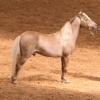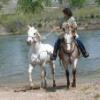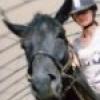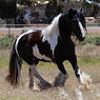Silver/MCOA images *graphic*
Forums
Re: Silver/MCOA images *graphic*
Bannerminis- Multiple Congenital Ocular Anomolies (MCOA, also known as ASD) is either caused by or very closely linked to the silver mutation. Heterozygous silvers present with just the temporal ciliary cysts while homozygous silvers can have a whole array of different anomolies. All the anomolies occur during the formation of the eye during embyrogenesis so the horses are born with them. The vast majority do not appear to affect vision appreciably.
ACC- both
Heather- thanks! I was so excited to be able to get these as I may be getting my paper published and would need images of my own.
Re: Silver/MCOA images *graphic*
[quote="supaspot60"]is it only silver carriers that can have this or does it ever occur in other colours ?[/quote]
There are other versions of genetic ocular anomolies. One is found in a specific line of Belgian drafts and another in quarterhorses (all progeny of one stud). Otherwise, the syndrome of MCOA is found in horses with at least one silver allele. The mutation that causes MCOA was narrowed down to PMEL17 locus, which is the location of silver. So either the MCOA mutation is very closely linked to silver or it is the same mutation.
[quote="accphotagraphy"]Huh... so I guess there is no difference in the pigment in an 'ee' eye as opposed to an 'E_'. That still make me wonder if there could be changes to hoof and skin color on red silvers.[/quote]
I am not sure. The ocular abnormalities occur in embryogenesis as the eyes form.
Re: Silver/MCOA images *graphic*
Really interesting research...
Can I ask a question.. Our silver mare (not homozygous) appears to have some vision issues at night, similar to the homozygous Appys (we owned a few spot once and he also acted the same way as she does)... Could this be related to the condition pictured here? You mentioned that heterozygous silver horses can also be affected to a degree?
Re: Silver/MCOA images *graphic*
[quote="tbtash"]Really interesting research...
Can I ask a question.. Our silver mare (not homozygous) appears to have some vision issues at night, similar to the homozygous Appys (we owned a few spot once and he also acted the same way as she does)... Could this be related to the condition pictured here? You mentioned that heterozygous silver horses can also be affected to a degree?[/quote]
From what I have found, heterozygotes appear to only have the ciliary cysts, which shouldn't affect vision. There is a possibility that the cysts are so large that they do distort light coming into the iris when it is dilated. I will look into it.
[quote="heather"]what QH stud? i have seen some bug eyed QHs and owned one.[/quote]
"Joyce et al. (1990) reported that a quarter horse stallion and seven offspring had iris hypoplasia, large, round and fixed pupils, absence of corpora nigra, and limbal dermoids. One additional offspring had normal eyes." I haven't looked up the original paper (will have to go dig in the library basement for it :D ). It sounds like it was a single mutation and none of those anomalies would cause bulging eyes. Also, it is the cornea that bulges out, not the whole eye. If you look at the amount of light that you can see passing through the normal horse cornea versus the MCOA one, there is a distinct difference. The irises are in approximately the same plane, but the cornea of the MCOA eye is more domed.
Re: Silver/MCOA images *graphic*
[quote="Danni"]Wow that's quite fasinating, I can actually see what you are talking about with the eye differences!! So is both the silver mini and the chestnut tested as homozygous silvers? Do you get the 'bug eyed' thing with heterozygous silvers?[/quote]
Neither was tested, but the homozygous silver being MCOA affected is hypothesized by breeding records and eye examination. Horses with anomalies more than just cysts always produced silver or red-based offspring. And then there is the paper than was publish that placed the MCOA mutation at the same location (PMEL17) as the silver mutation. You will only get the bugged-eyed appearance (cornea globosa) with a homozygous horse. The only anomaly seen in heterozygotes is the ciliary cysts.









Re: Silver/MCOA images *graphic*
I have never heard of that before.
So could you explain a little on what causes it? Is it horses that are homozygous or is it a hereditary thing?
I have never seen such buggy eyes before